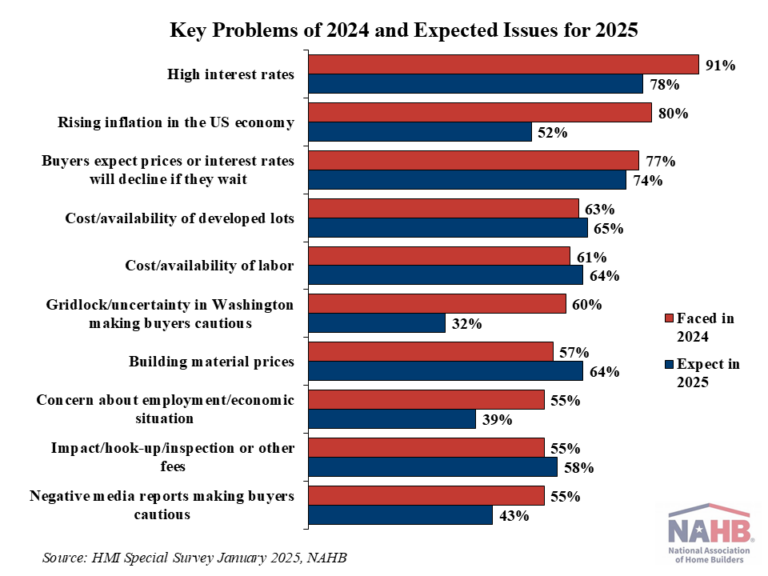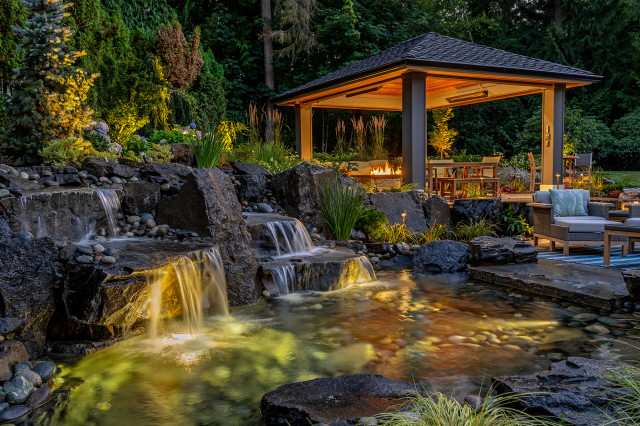The most significant challenge builders faced in 2024 was high interest rates, as reported by 91% of builders in the latest NAHB/Wells Fargo Housing Market Index survey. A smaller, albeit still significant share of 78% expect interest rates to remain a problem in 2025. The next four most serious issues builders faced in 2024 were rising inflation in the U.S. economy (80%), buyers expecting prices/interest rates to decline (77%), the cost/availability of developed lots (63%), and the cost/availability of labor (61%). Builders don’t expect much improvement in these challenges in 2025, except for rising inflation, which ‘only’ 52% see as a serious problem in the year ahead.
In addition to those top tier challenges, 55% to 60% of builders also reported facing serious problems in 2024 with gridlock/uncertainty in Washington (60%), building material prices (57%), concern about employment/economic situation (55%), impact/hook-up/inspection and other fees (55%), and negative media reports making buyers cautious (55%). Looking ahead at 2025, significantly fewer builders expect gridlock/uncertainty in Washington (32%) or have concerns about the employment/economic situation (39%). In contrast, more builders are expecting building material prices to be a problem in 2025 (64%) and about the same expect continuing problems with impact and other fees (58%).
Builders have been asked about their most serious challenges every year since 2011. High interest rates have been a problem for a negligible share of builders (under 10%) during most years, except for 2022 (66%), 2023 (90%), and 2024 (91%). When first introduced to the survey in 2021, 63% of builders reported challenges with rising inflation in the U.S. economy, but the share grew to at least 80% in 2022, 2023, and 2024. Prior to 2022, relatively few builders reported problems with buyers expecting prices or interest rates to fall, but that share rose to 49% in 2022, 71% in 2023, and 77% in 2024.
The cost/availability of developed lots has been a serious challenge to most builders in nine of the 14 years of the series history. In 2022, 51% of builders faced this problem; by 2024, 63% did—tying a record high set in 2019. Meanwhile, more than half of builders have reported the cost/availability of labor as a serious problem for the past 11 years in a row. While 82% and 85% of builders faced this challenge in 2021 and 2022, respectively, the share has eased to 73% in 2023 and to 61% in 2024.
For additional details, including a complete history for each reported and expected problem listed in the survey, please consult the full survey report.
Discover more from Eye On Housing
Subscribe to get the latest posts sent to your email.
This article was originally published by a eyeonhousing.org . Read the Original article here. .





Bringing a fresh look to a historical home’s landscape while still maintaining some original charm means navigating a fine line between past and present.
Challenge: Designer Sara Yant of Twistleaf was tasked with reimagining outdoor spaces in the Historic District of Fredericksburg, Texas, including for a Queen Anne Victorian mansion, a carriage house, a five-unit barn conversion and three 1930s bungalows. “We needed to create a cohesive look that would complement the different architectural styles and prioritize an intuitive circulation between the spaces,” Yant says.
There were some hiccups along the way that impacted the original plan. A long-abandoned and crumbling drainage pipe beneath the mansion’s front yard was a safety risk. Stringent watering restrictions also were implemented for the Texas Hill Country during that time.
Solution: Yant replaced the fencing and gates with period-appropriate designs. She also updated the hardscape using a mix of concrete, bricks and decomposed granite to create paths and relaxing courtyards and retreats. Removing the crumbling pipe allowed her to reinforce the surrounding ground.
She finished the space with a mix of native and adapted plants that complement the architecture of the Queen Anne Victorian home. Black and blue sage and soft leaf yucca provide seasonal interest and attract butterflies and hummingbirds. American beautyberries (Callicarpa americana, USDA zones 6 to 10; find your zone), dwarf palmetto palms (Sabal minor, zones 7 to 10), aromatic aster (Symphyotrichum oblongifolium, zones 3 to 9) and inland sea oats (Chasmanthium latifolium, zones 3 to 8) define the restorative green retreat by the bungalows.
“We also reduced the amount of lawn in the original design and replaced several areas [including the space shown here], with Leavenworth’s sedge (Carex leavenworthii, zones 6 to 9) as a water-conscious solution,” Yant says.